Analysis of Solid-Liquid Two-Phase Flow in the Area of Rotor and Tailpipe
Abstract
:1. Introduction
2. Design Process and Model Building
2.1. Physical Model
2.2. Mesh Classification and Model Building
2.3. Grid-Independent Verification
2.4. Boundary Conditions
2.5. Numerical Calculation Method
2.6. Reliability Verification
3. Result
3.1. Flow Analysis of the Rotor Domain
3.2. Tailpipe Domain Flow Analysis
3.3. Effect of Two-Phase Flow Conditions on the External Characteristics of the Unit
3.4. Pressure Pulsation Analysis
3.5. Pressure Pulsation Analysis with Different Solid-Phase Concentrations
3.6. Wear Characteristics Analysis
4. Conclusions
- (1)
- Under the two-phase flow condition, the maximum pressure distribution in the XY plane of the turbine is positively correlated with the solid-phase diameter and concentration, and both are larger than that of the clear water condition. The liquid-phase velocity of the XY cross-section is negatively correlated with the solid-phase diameter, and positively correlated with the solid-phase concentration, and the addition of solid-phase particles makes it easier to produce cavitation and vortex in the area of the tailpipe, and the performance of the tailpipe area in terms of energy recovery deteriorates. The high-concentration zone of the XY plane is mainly located in the runner area and the inlet of the tailpipe. The inlet is positively correlated with the size of solid-phase diameter and concentration. The maximum pressure, solid-phase velocity and solid-phase concentration distribution on the surface of the guide vane are positively correlated with the inlet solid-phase diameter and concentration, and the solid-phase velocity and concentration distribution on the back of the guide vane are larger than those on the front, so it is more likely to produce wear on the back of the guide vane. The addition of solid-phase particles leads to more obvious wear on the inlet side of the back of the blade, which makes its cavitation performance worse, and the pressure difference between the front and back of the blade is greater than that of the clear water condition under two-phase flow condition.
- (2)
- The addition of the solid phase changed the time-domain period of pressure pulsation at the inlet of the runner and the inlet of the tailpipe under the clear water condition. The main frequency at the inlet of the runner and the inlet of the tailpipe is the rotor frequency or the leaf frequency, and the middle section of the tailpipe is the low-frequency pressure pulsation, and the pressure pulsation coefficient decreases with the increase of the concentration of the solid phase in the middle section of the tailpipe. The pressure pulsation coefficients corresponding to the main frequency at each monitoring point of the runner inlet and the tailpipe inlet increase with the increase of the diameter and concentration of the solid phase.
Author Contributions
Funding
Data Availability Statement
Conflicts of Interest
References
- Huang, Y. Research and practice on the effect of river sand on turbine wear in China. Hydropower 2005, 31, 56–58. [Google Scholar]
- Xue, W.; Chen, Z. Study on the theory of cavitation and abrasion of hydraulic turbine. Large Electr. Mach. Technol. 1999, 6, 44–48. [Google Scholar]
- Lu, L.; Gao, Z.; Pan, L.; Ma, S. Development and review of the field of hydraulic electromechanical research in the past 50 years. J. China Inst. Water Resour. Hydropower Res. 2008, 4, 299–307. [Google Scholar]
- Ge, X.; Sun, J.; Cai, J.; Jiang, M.; Han, Y.; Wang, J.; Zhang, L.; Wu, E.; Zheng, Y. Study of solid-liquid two-phase flow in an ultra-low head two-blade bulb cross-flow hydraulic turbine. Chin. J. Electr. Eng. 2022, 42, 1481–1494. [Google Scholar]
- Peng, S. Numerical Simulation of Solid-Liquid Two-Phase Flow in Cross-Flow Turbine Based on Vortex Analysis. Master’s Thesis, Xihua University, Chengdu, China, 2020. [Google Scholar]
- Han, W.; Chen, Y.; Liu, Y.; Wei, S.; Li, G.; Jin, J. Prediction of abrasion morphology evolution of active guide vane end gap of hydraulic turbine. J. Agric. Eng. 2018, 34, 100–107. [Google Scholar]
- Wu, W.; Wu, Y.; Ren, J.; Tang, X. Prediction of internal wear of hydraulic turbine runners. J. Eng. Thermophys. 2000, 21, 709–712. [Google Scholar]
- Kang, M.-W.; Park, N.; Suh, S.-H. Numerical study on sediment erosion of Francis turbine with different operating conditions and sediment inflow rates. Procedia Eng. 2016, 157, 457–464. [Google Scholar] [CrossRef]
- Neopane, H.P. Sediment Erosion in Hydro Turbines. Ph.D. Thesis, Norwegian University of Science and Technology (NTNU), Trondheim, Norway, 2010. [Google Scholar]
- Nishi, Y.; Hatano, K.; Inagaki, T. Study on performance and flow field of an undershot cross-flow water turbine comprising different number of blades. J. Therm. Sci. 2017, 26, 413–420. [Google Scholar] [CrossRef]
- Yang, W.; Wu, Y.; Liu, S. A modification method on runner blades in a Bulb turbine. IOP Conf. Ser. Earth Environ. Sci. 2010, 12, 012003. [Google Scholar] [CrossRef]
- Ferrer, E.; Willden, R.H.J. Blade–wake interactions in cross-flow turbines. Int. J. Mar. Energy 2015, 11, 71–83. [Google Scholar] [CrossRef]
- Lemay, S.; Aeschlimann, V.; Fraser, R.; Ciocan, G.D.; Deschênes, C. Velocity field investigation inside a bulb turbine runner using endoscopic PIV measurements. Exp. Fluids 2015, 56, 120. [Google Scholar] [CrossRef]
- Park, J.H.; Lee, N.J.; Wata, J.V.; Hwang, Y.C.; Kim, Y.T.; Lee, Y.H. Analysis of a pico tubular-type hydro turbine performance by runner blade shape using CFD. IOP Conf. Ser. Earth Environ. Sci. 2012, 15, 042031. [Google Scholar] [CrossRef]
- Wilhelm, S.; Balarac, G.; Métais, O.; Ségoufin, C. Head losses prediction and analysis in a bulb turbine draft tube under different operating conditions using unsteady simulations. IOP Conf. Ser. Earth Environ. Sci. 2016, 49, 022010. [Google Scholar] [CrossRef]
- Sun, L.G.; Guo, P.C.; Zheng, X.B.; Luo, X.Q. Numerical investigation of cavitation performance on bulb tubular turbine. IOP Conf. Ser. Mater. Sci. Eng. 2016, 129, 012039. [Google Scholar] [CrossRef]
- Vu, T.C.; Gauthier, M.; Nennemann, B.; Wallimann, H.; Deschênes, C. CFD analysis of a bulb turbine and validation with measurements from the BulbT project. IOP Conf. Ser. Earth Environ. Sci. 2014, 22, 022008. [Google Scholar] [CrossRef]
- Choi, Y.-D.; Son, S.-W. CFD Analysis on the Performance and Internal Flow of a Micro Cross-Flow Hydro Turbine in the Range of Very Low Specific Speed. KSFM J. Fluid Mach. 2012, 15, 25–30. [Google Scholar] [CrossRef]
- Sha, Y.; Liu, X. Performance test on solid-liquid two-phase flow hydrotransport of vortex pump. Editor. Off. Trans. Chin. Soc. Agric. Eng. 2013, 29, 76–82. [Google Scholar]
- Wang, L.; Li, B.; Zhao, W. Dynamics and Wear Analysis of Hydraulic Turbines in Solid-liquid Two-phase Flow. Open Phys. 2019, 17, 790–796. [Google Scholar] [CrossRef]
- Chen, L.; Zhao, Z.; Zhang, S.; Sun, Y. Effect of Particle Shape on Pipeline Damage in Liquid-Solid Two-Phase Flow. J. Phys. Conf. Ser. 2019, 130, 012099. [Google Scholar] [CrossRef]
- Tao, Y.; Bai, Y.; Wu, Y. Influence of Blade Thickness on Solid–Liquid Two-Phase Flow and Impeller Wear in a Ceramic Centrifugal Slurry Pump. Processes 2021, 9, 1259. [Google Scholar] [CrossRef]
- Zhou, W.; Chai, J.; Xu, Z.; Cao, C.; Wu, G.; Yao, X. Numerical Simulation of Solid-Liquid Two-Phase Flow and Wear Prediction of a Hydraulic Turbine High Sediment Content. Exp. Tech. 2022, 47, 281–293. [Google Scholar] [CrossRef]
- Zhao, Y.; Liao, W.; Li, Z.; Ruan, H.; Luo, X. Flow field performance of bulb turbine with C-type or S-type blades. Editor. Off. Trans. Chin. Soc. Agric. Eng. 2013, 29, 47–53. [Google Scholar]


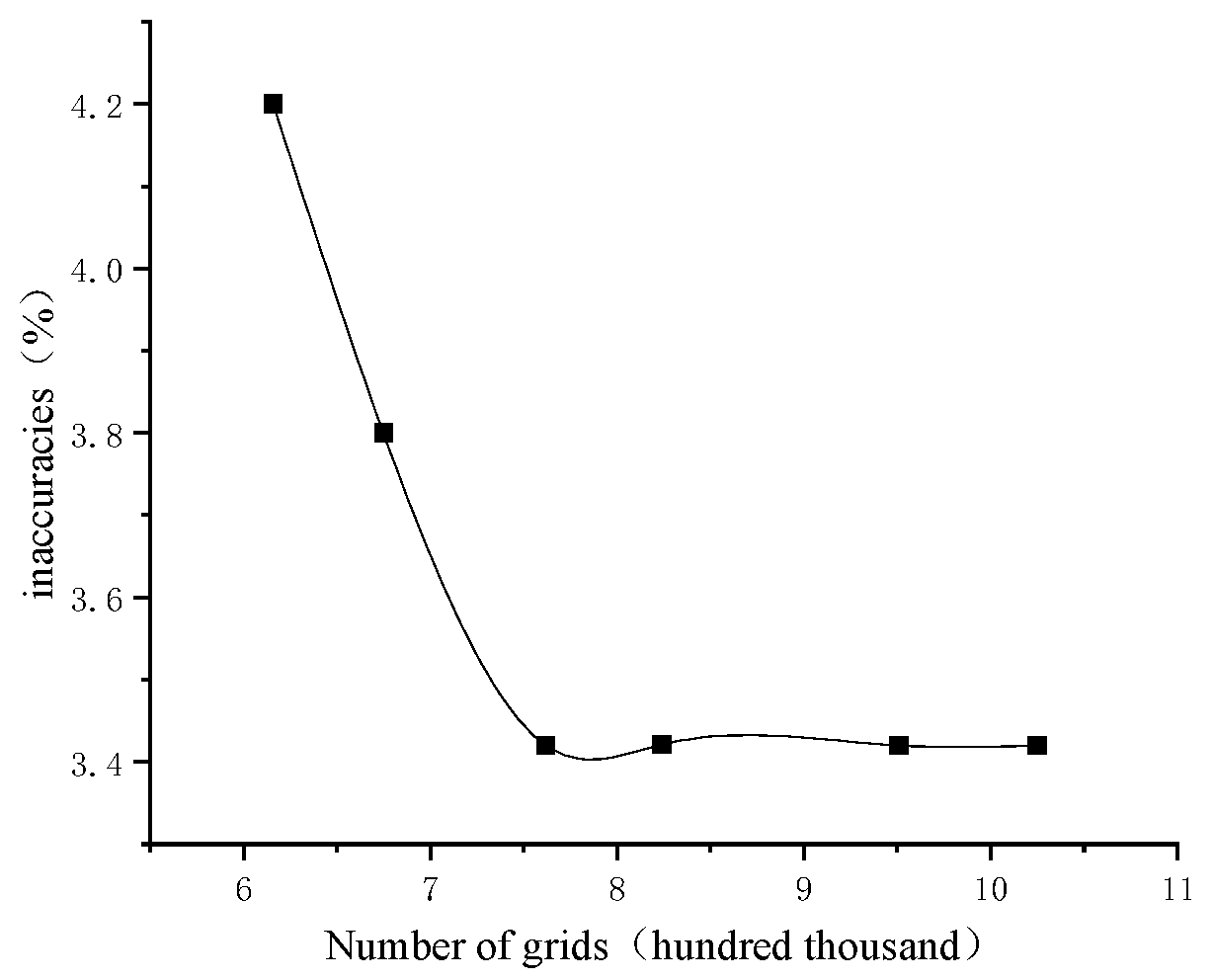
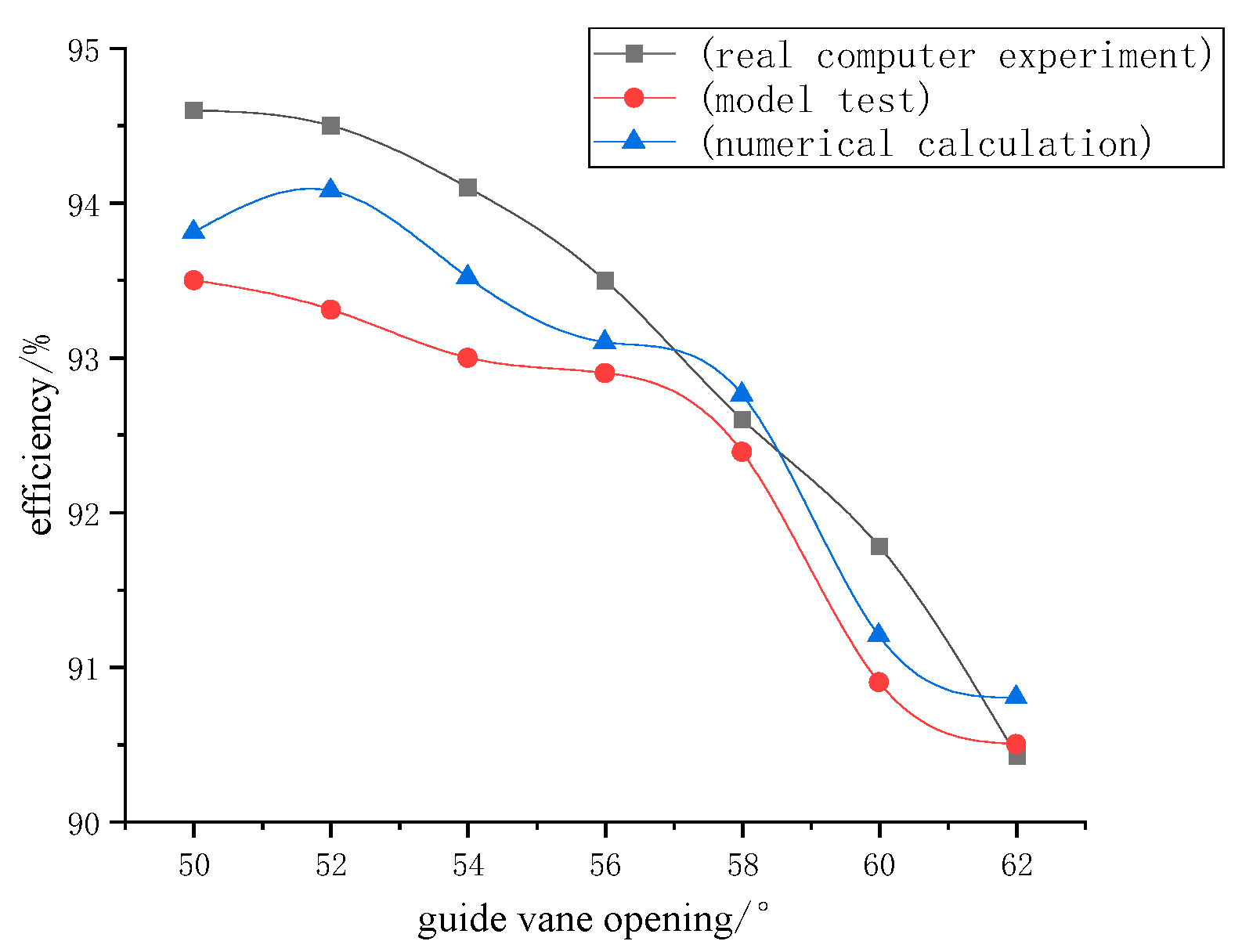

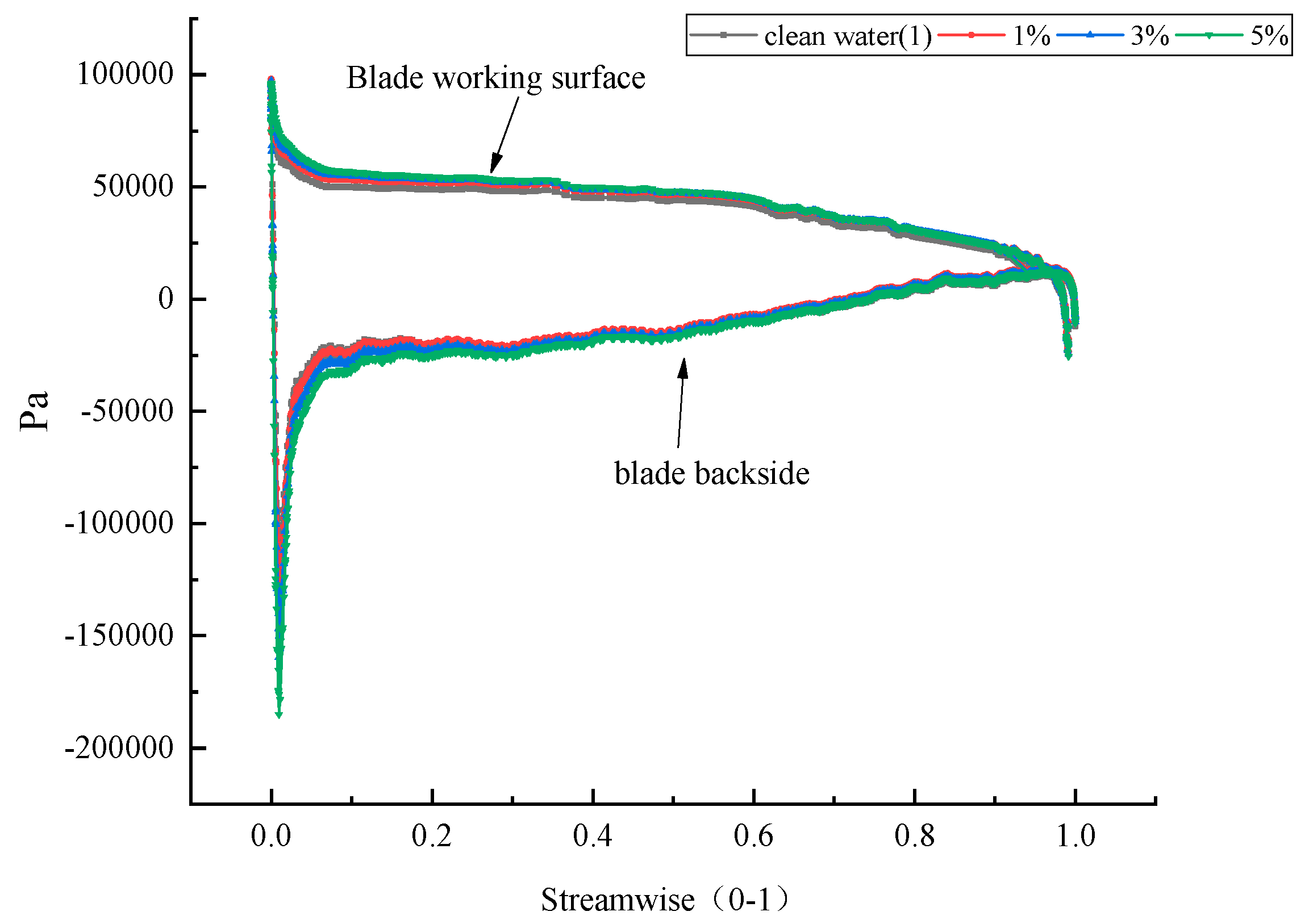
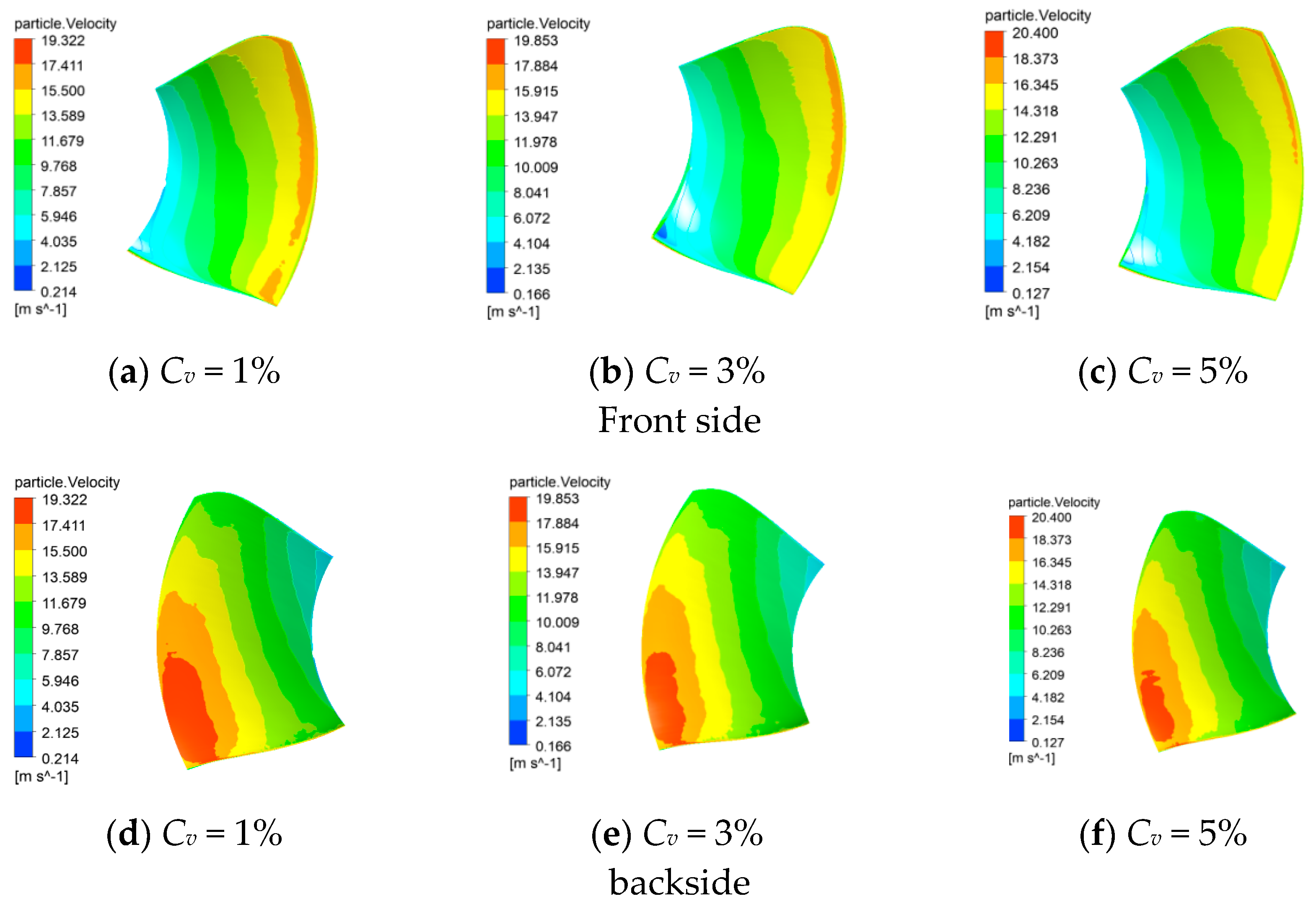
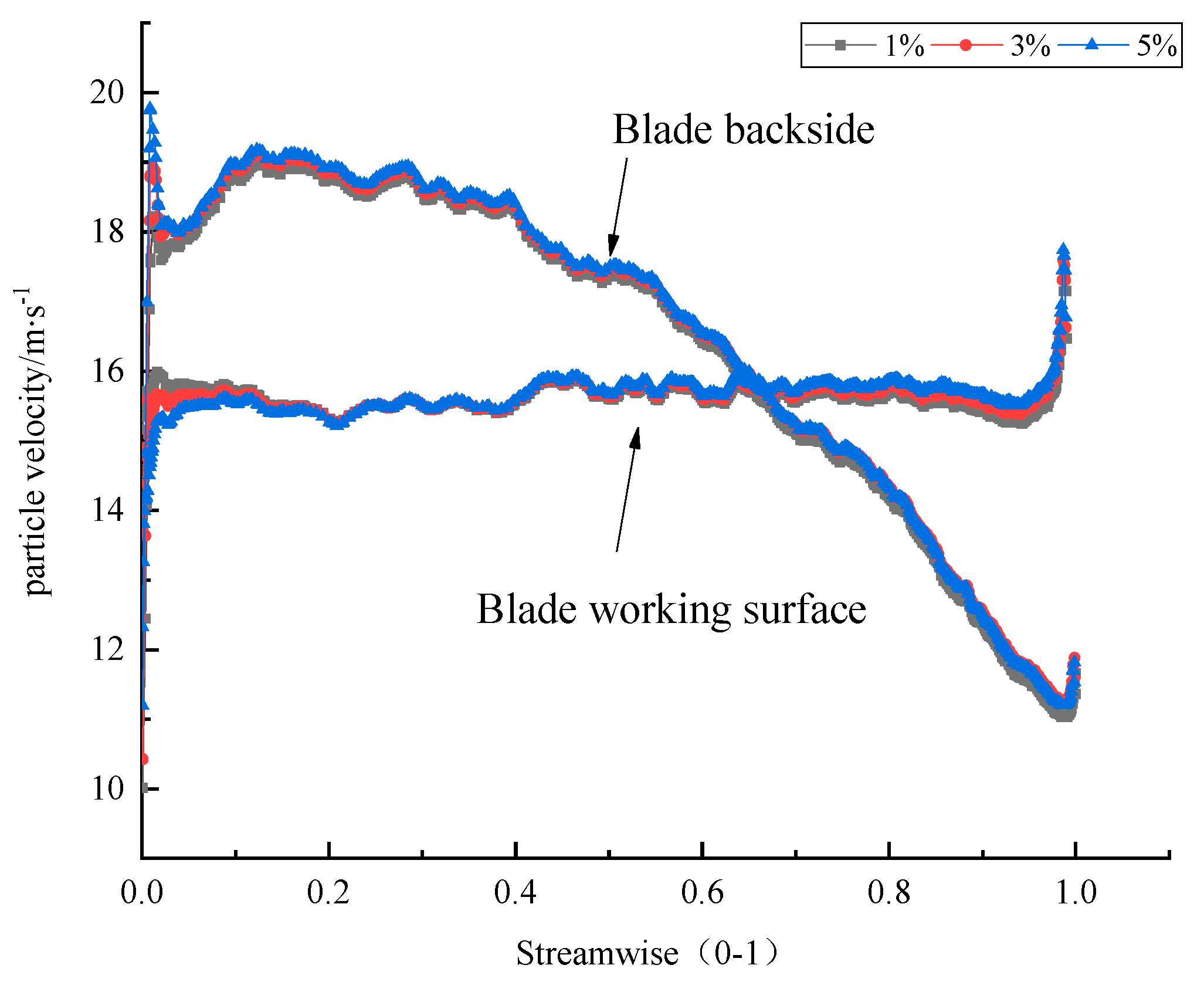
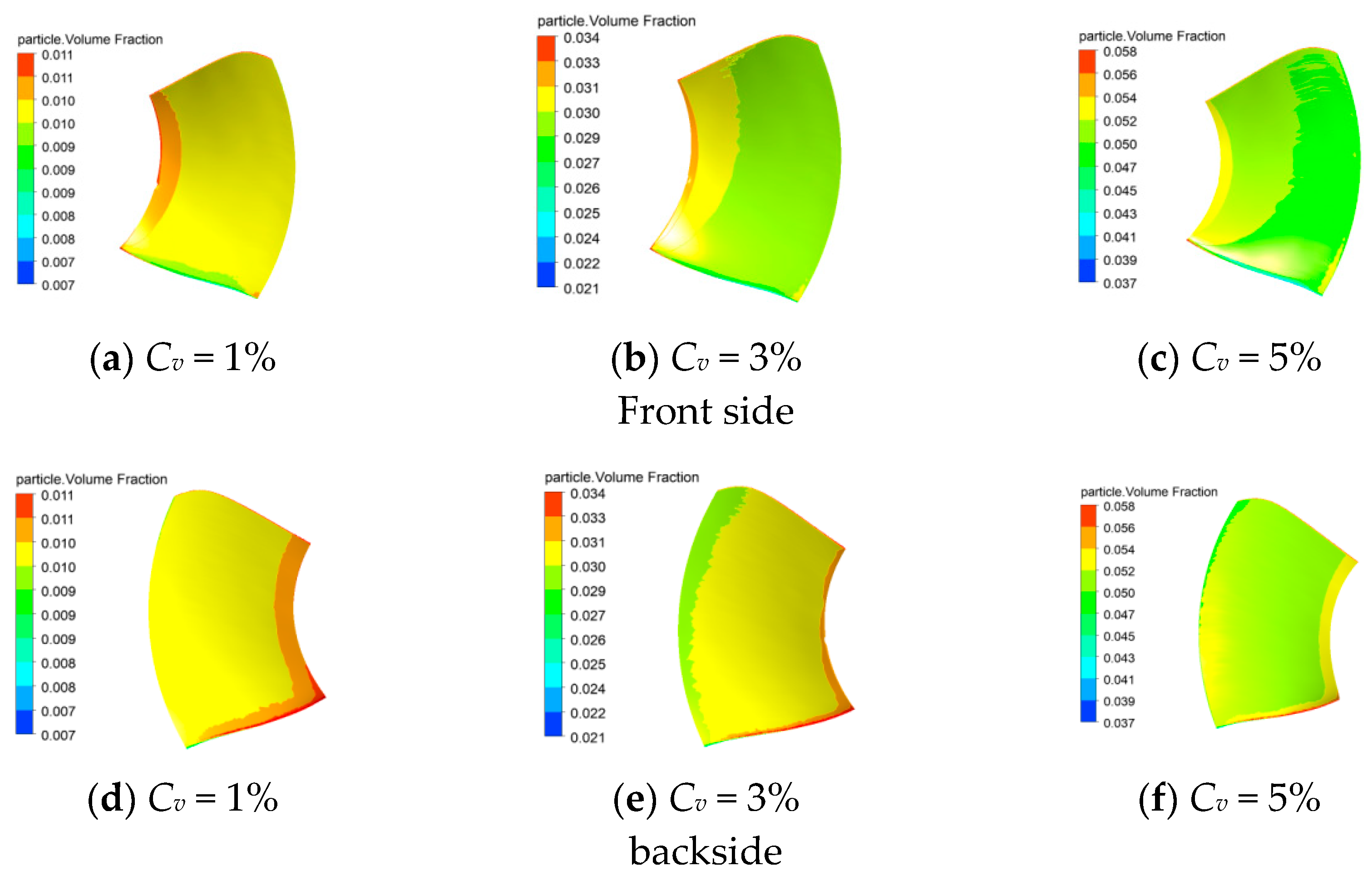


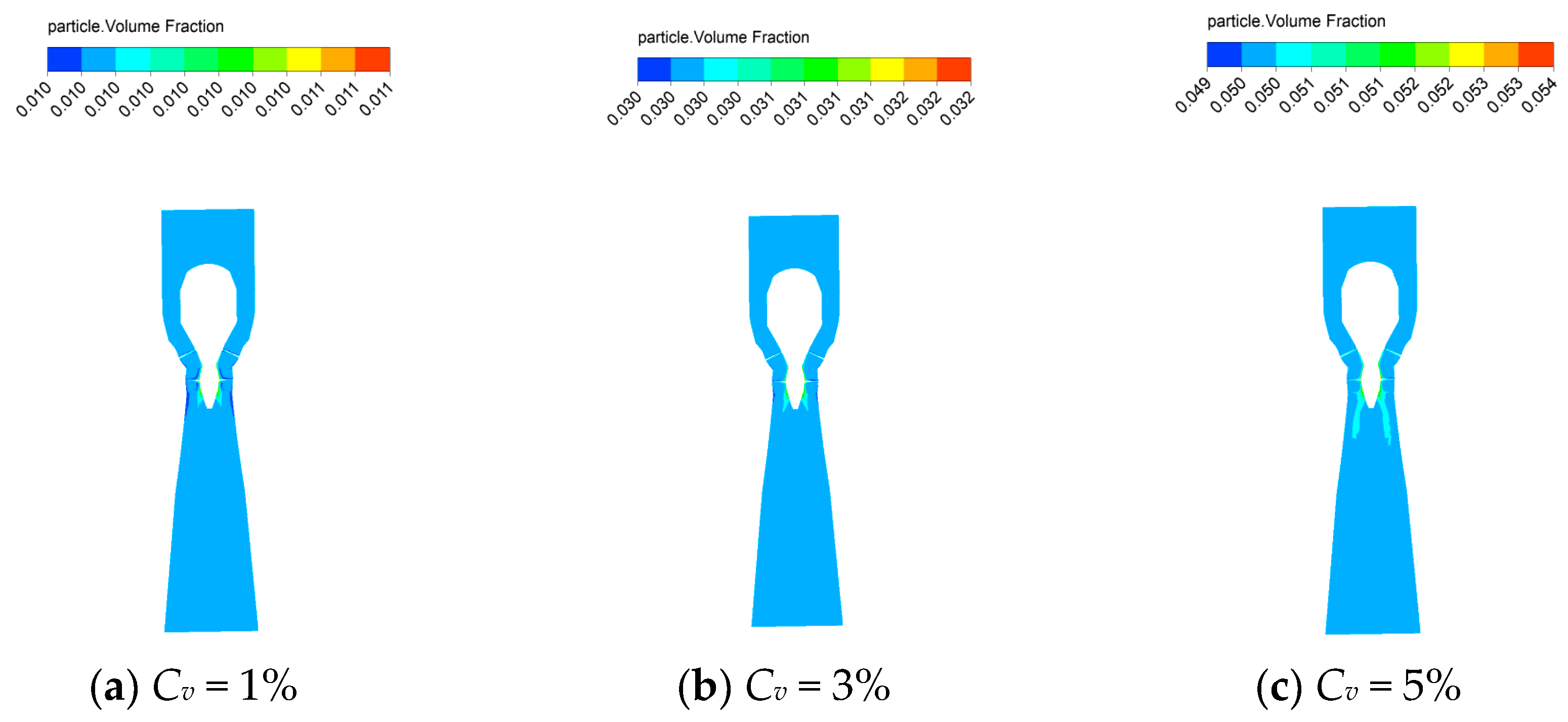

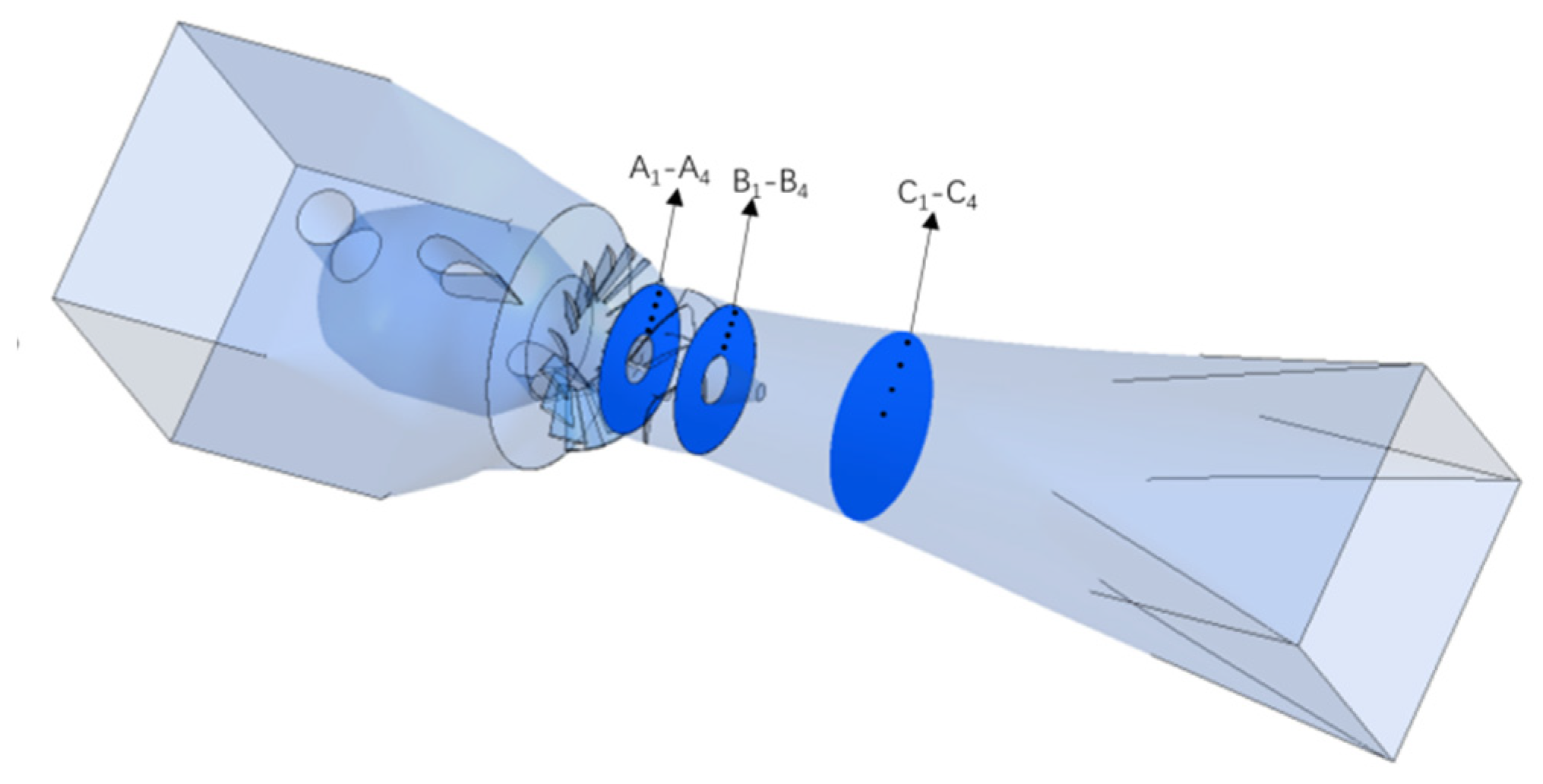


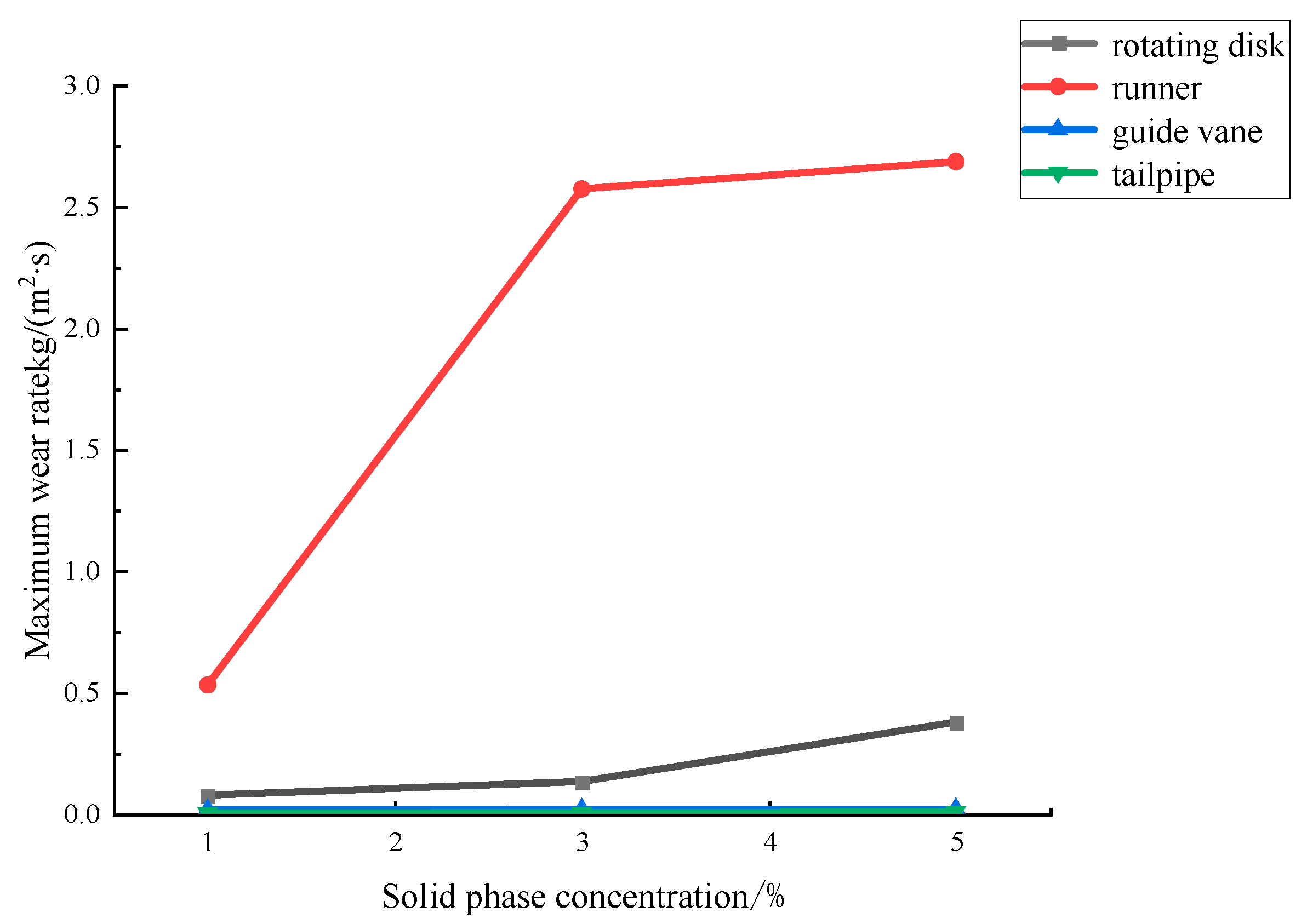
| Number of blades/pc | 4 |
| Active guide leaf/pc | 16 |
| Rotor diameter/mm | 5500 |
| Angle range of paddle | 7~43° |
| Angle range of guide vane | 14~75° |
| Diameter of tailpipe inlet/mm | 5588 |
| Diameter of tailpipe outlet/mm | 9305 |
| Rated head/m | 6.85 |
| Rated flow rate/m3/s | 246.74 |
| Rated speed of real machine/r/min | 85.71 |
Disclaimer/Publisher’s Note: The statements, opinions and data contained in all publications are solely those of the individual author(s) and contributor(s) and not of MDPI and/or the editor(s). MDPI and/or the editor(s) disclaim responsibility for any injury to people or property resulting from any ideas, methods, instructions or products referred to in the content. |
© 2023 by the authors. Licensee MDPI, Basel, Switzerland. This article is an open access article distributed under the terms and conditions of the Creative Commons Attribution (CC BY) license (https://creativecommons.org/licenses/by/4.0/).
Share and Cite
Xie, G.; Li, Q.; Xin, L.; Li, Z. Analysis of Solid-Liquid Two-Phase Flow in the Area of Rotor and Tailpipe. Processes 2023, 11, 3382. https://doi.org/10.3390/pr11123382
Xie G, Li Q, Xin L, Li Z. Analysis of Solid-Liquid Two-Phase Flow in the Area of Rotor and Tailpipe. Processes. 2023; 11(12):3382. https://doi.org/10.3390/pr11123382
Chicago/Turabian StyleXie, Gengda, Qifei Li, Lu Xin, and Zhanyong Li. 2023. "Analysis of Solid-Liquid Two-Phase Flow in the Area of Rotor and Tailpipe" Processes 11, no. 12: 3382. https://doi.org/10.3390/pr11123382




